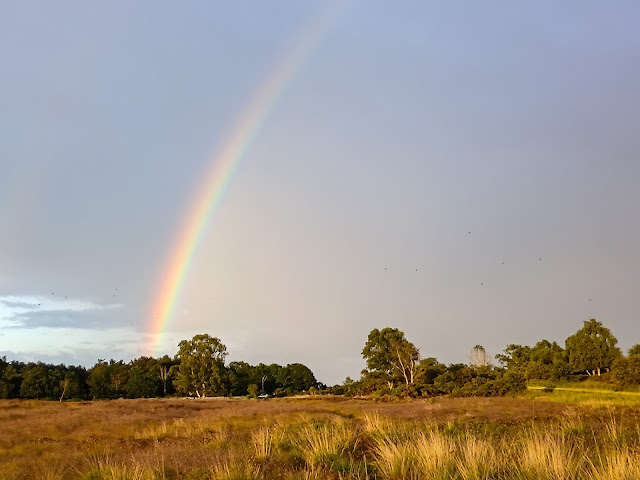On 15th June 2024, I visited the following site:
EWT Wrabness, Essex
RSPB Minsmere, Suffolk
WestletonHeath, Suffolk
After picking up my rental car and driving home, I then drove to EWT Wrabness.
EWT Wrabness comprises hedgerows, scrub and grassland plus views
overlooking the River Stour estuary. It is primarily known as a breeding
location for Turtle Dove, a rapidly declining species which can be very difficult
to locate now in the UK although this site remains a stronghold in Essex.
Compared with my previous visits, locating any Turtle Doves proved to be difficult although I did eventually hear a single “purring” male which frustratingly remained out of sight. Despite a good range of other species given the persistent drizzle, I failed to hear or see any Nightingales which was also disappointing given that EWT Wrabness is also a reliable site for this species.
The highlights during my visit were as follows (heard only records in italics): Turtle Dove (1 “purring” male heard), Lesser Whitethroat (1 singing male heard), Common Whitethroat (2 singing males seen, 2 other birds seen and 2 other singing males heard), Blackcap (2 singing males heard), Chiffchaff (1 singing male seen, 1 other bird seen and 3 other singing males heard), Sand Martin (c.15), Cetti’s Warbler (3 singing males), Yellowhammer (1 singing male heard), Skylark (1 singing male heard), Linnet (1), Greenfinch (3 males and 1 female), Goldfinch (c.10), Mistle Thrush (2), Little Egret (1), Oystercatcher (2)
Addition to 2024 UK year list: Turtle Dove
After my visit to EWT Wrabness, I drove up to Suffolk and my second visit of the spring to RSPB Minsmere.
RSPB Minsmere is one of the oldest
reserves owned and managed by the RSPB and it is
designated as a Site of Special Scientific Interest,
a Special Area of Conservation,
a Special Protection Area and
a Ramsar site. It is also 1 of only 5 European Council Diploma Protected
Areas in the UK. Habitats at RSPB Minsmere include
reedbeds, marshland, scrapes, grassland, heathland and shingle beach and a huge
number and diversity of species is present at any time of the year.
Compared with my earlier visit on 2nd May 2024, this visit was much less productive in terms of the number of species recorded, not helped by the extremely strong wind and the intermittent heavy rain showers.
Nonetheless, I still had a very rewarding visit and highlights included the following (heard only records in italics): Avocet (c.200), Black-tailed Godwit (c.100), Oystercatcher (2), Lapwing (c.10), Ringed Plover (2), Shelduck (c.20), Shoveler (c.20), Gadwall (c.15), Mallard (c.10), Teal (c.15), Sandwich Tern (at least 200), Common Tern (at least 100), Kittiwake (15), Lesser Black-backed Gull (c.10), Black-headed Gull (+++ large nesting colony including many juveniles), Coot (c20), Moorhen (3), Egyptian Goose (1), Canada Goose (c.20), Greylag Goose (2 plus 2 juveniles), Chiffchaff (2 singing males heard), Blackcap (1 singing male heard), Reed Warbler (1), Sedge Warbler (1 singing male), Sand Martin (c.30), Marsh Harrier (1), Hobby (5), Rabbit (1), Red Admiral (1), Speckled Wood (1)
Addition to 2024 UK year list: Kittiwake
My final visit of the day was to nearby NNR Westleton Heath where my main target species was
Nightjar.
NNR Westleton Heath is part of the best remaining tract of heathland in Suffolk and located just outside the village of Westleton. In medieval times a large area of heath known as the Sandlings (on account of its dry sandy soils) stretched along the Suffolk coast. Today only about 20% of the heathland remains and the rest has been lost to modern farming and forestry. The site is particularly good for heathland and woodland species.
I have visited NNR Westleton Heath many times over the years but this was my best ever encounter with Nightjars with exceptionally close flight views of 3 males in still relatively good light plus the sound of regular “churring”, calling and wing-clapping.
The highlights during my visit were as follows: Nightjar (3 males), Kestrel (1 male), Swift (5), Yellowhammer (1 male)
Addition to 2024 UK year list: Nightjar
Apart from the wildlife highlights, there was also a full rainbow whilst I waited for the sun to set.
Stay safe, stay well, stay strong, stay connected with nature






No comments:
Post a Comment
If you feel like commenting on my blog, you can contact me by completing the comment form below. I will respond to all comments and enquiries and constructive criticism will always be welcomed.